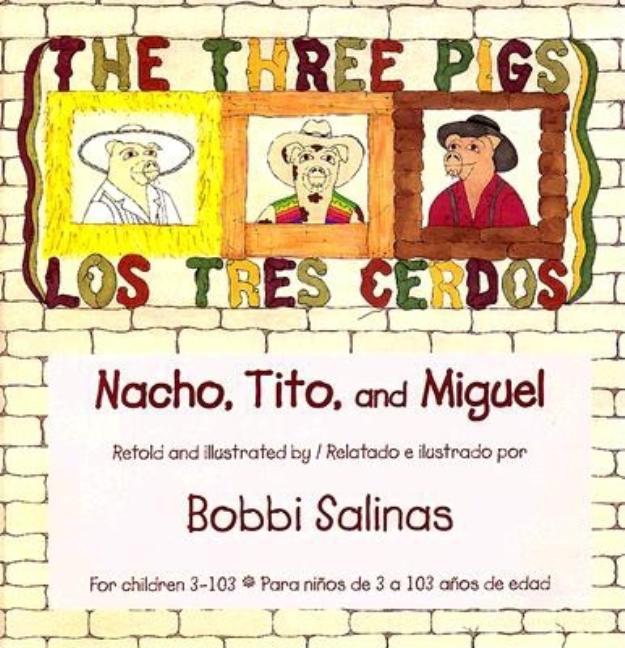
BIBLIOGRAPHY
Salinas, Bobbi. The Three Pigs/Los Tres Cerdos: Nacho, Tito and Miguel. Spanish version written by Amapola Franzen and Marcos Guerrero. Oakland, CA: Piñata Publications, 1998. ISBN 0934925054
PLOT SUMMARY
In the beginning of this southwestern retelling, piglets and sow bid each other a tearful adios as the boys decide to strike out on their own. Mamá leaves her three pigs with a warning: watch out for José, the wily wolf. The first pig, Nacho, finds a good plot of land and makes himself a desert home out of straw, but—as in the original tale—José the wolf is quick to blow his house down. The unfortunate Nacho is then locked in a pigpen, awaiting suppertime when he’ll be made into delicious carnitas or chicharrons. Nacho’s brother, Tito, doesn’t fare much better after building his house out of wood. But Miguel, the third brother who builds his house out of adobe, keeps José at bay. The wicked wolf tries various tricks to fool Miguel into coming outside, but Miguel gets the better of José each time. The wolf is finally so angry at being outsmarted that he climbs down Miguel’s chimney to eat up the smug pig. Unfortunately for José, Miguel has his famous hot green chile stew boiling at the chimney’s bottom. After performing first aid and showing a sad-looking burnt wolf to the door, Miguel frees his brothers and they sit down to a delicious dinner.
CRITICAL ANALYSIS
Los Tres Cerdos is an excellent retelling of the original “Three Little Pigs.” Like its predecessor, the book includes the trademark elements of straw, wood, and brick; of one naughty wolf; of huffing and puffing and blowing houses down; and of not opening the door by the hairs of the pigs’ “chinny-chin-chins.” Yet the book also retells the tale with its own unique flair, adding clever new additions like “No way, José,” chicharron pig snacks, and Miguel’s hot green chile stew. Furthermore, the Spanish words and translations are spot on, and the book includes an index to help readers gain additional insights into the Spanish words and southwestern cultural images found in the illustrations and dialogue.
And speaking of the illustrations, Salinas’s detailed naïve style adds fantastic depth to her retelling. Observant readers will be able to use context clues from household items to note that Nacho is a piano player, that Tito is an aspiring artist, and that Miguel is a book-loving scholar. The illustrations also give the story its distinct Spanish-American flair with nods to cultural icons like the “Mona Frida,” hung from Tito’s wall; the Virgin of Guadalupe, framed in Mamá’s house; and a Gabriel García Márquez novel, sitting on Miguel’s shelf. Details make Los Tres Cerdos come alive.
Most importantly, readers will appreciate this non-violent retelling for its commitment to both mercy and justice. The wolf gets to go home alive, penitent but chastised. The pig brothers get to enjoy a delicious southwestern meal together and live in their safe and sturdy adobe houses happily ever after. With exceptional attention to detail in the language, culture, and illustration, this retelling would make a great addition to any library collection.
AWARDS AND REVIEW EXCERPTS
Winner of the 1999 Tomás Rivera Book Award
From Publishers Weekly: “This book offers a spicy retelling of the familiar tale of the three little pigs . . . The excellent illustrations are entertaining, intelligent, and witty, offering lots of visual jokes and cross-cultural references to the likes of Elvis Presley, César Chávez, and Cantinflas . . . Highly recommended for all bookstore and library collections.”
CONNECTIONS
- Put on a classroom play of the story using the costume suggestions found in the back of the book.
- Work together to recreate green chile stew using the recipe found in the back of the book or pre-prepare stew and eat it together.
- Read with other Tomás Rivera Mexican American Children’s Book Award winners:
- Lomas Garza, Carmen. In My Family/En Mi Familia. ISBN 9780892391639
- Mora, Pat, and Raul Colón (illustrator). Tomás and the Library Lady. ISBN 9780613283625
- Morales, Yuyi. Just a Minute!: A Trickster Tale and Counting Book. ISBN 9780811837583
- Read with other cultural retellings of “The Three Little Pigs.” Then, compare and contrast the retellings together:
- Brett, Jan. The 3 Little Dassies. ISBN 9780399254994
- Ketteman, Helen, and Will Terry (illustrator). The Three Little Gators. ISBN 9780807578247
- Kimmel, Eric A., and Leo and Valeria Docampo (illustrator). The Three Little Tamales. ISBN 9780761455196
*Note—This book review was created as an assignment for a course at Texas Woman’s University.